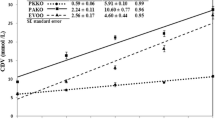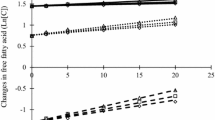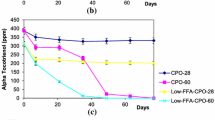Abstract
Oxidative stability of cold-pressed plum (Prunus domestica) kernel oil (PKO), and apricot (Prunus armeniaca) kernel oil (AKO) were evaluated under thermal-oxidation and photo-oxidation conditions. Changes in peroxide value (PV), conjugated dienes (K232), and levels of volatile compounds in the cold-pressed oils were monitored during storage for 12 days under oxidation conditions. Under thermal oxidation conditions, PV values of PKO reached the maximum value (63.8 meq O2/kg) after 12 days of storage, while PV values of AKO reached the maximum value (54.5 meq O2/kg) after 10 days of storage. K232 values exhibited similar behavior under accelerated oxidation conditions, wherein the highest K232 values were 12.38 and 10.91 for PKO and AKO at the 12th and the 10th day of storage, respectively. Under photo-oxidation conditions, both values recorded similar behavior. At the end of storage (12th day), PV values reached 117.5 and 67.62 meq O2/kg for PKO and AKO, respectively. Similarly, the maximum K232 values were 5.72 and 4.56 for PKO and AKO, respectively. Hexanal, and E-2-heptenal recorded the values of 149.2 and 41.83 × 106 AU for the PKO after 12 days of storage under thermal oxidation conditions, while hexanal, and E-2-heptenal reach up to 199.2 and 58.88 × 106 AU for the AKO after only 10 days of storage. At the end of 12 days of storage under photo-oxidation of PKO and AKO, the aldehydes were detected as the most identified chemical group (especially hexanal, and E-2-heptenal) in the photo-oxidized PKO and AKO.




Similar content being viewed by others
Abbreviations
- AKO:
-
Cold-pressed apricot kernel oil
- PKO:
-
Cold-pressed plum kernel oil
- PV:
-
Peroxide value
- K232 :
-
Conjugated diene
- IUPAC:
-
International Union of Pure and Applied Chemistry
- GC:
-
Gas chromatography
- FAME:
-
Fatty acid methyl esters
- SPME:
-
Solid phase micro extraction
- KI:
-
Kovats index
References
Dulf FV, Vodnar DC, Socaciu C (2016) Effects of solid-state fermentation with two filamentous fungi on the total phenolic contents, flavonoids, antioxidant activities and lipid fractions of plum fruit (Prunus domestica L.) by-products. Food Chem 209:27–36
Özdikicierler O, Yemişçioğlu F, Gümüşkesen AS (2016) Effects of process parameters on 3-MCPD and glycidyl ester formation during steam distillation of olive oil and olive pomace oil. Eur Food Res Technol 242:805–813
Aguilar T, Loyola C, de Bruijn J, Bustamante L, Vergara C, von Baer D, Mardones C, Serra I (2016) Effect of thermomaceration and enzymatic maceration on phenolic compounds of grape must enriched by grape pomace vine leaves and canes. Eur Food Res Technol 242:1149–1158
Hammouda IB, Zribi A, Ben Mansour A, Matthäus B, Bouaziz M (2017) Effect of deep-frying on 3-MCPD esters and glycidyl esters contents and quality control of refined olive pomace oil blended with refined palm oil. Eur Food Res Technol. doi:10.1007/s00217-016-2836-4 (in press)
Górnaś P, Rudzińska M, Raczyk M, Mišina I, Soliven A, Lācis G, Segliņa D (2016) Impact of species and variety on concentrations of minor lipophilic bioactive compounds in oils recovered from plum kernels. J Agric Food Chem 64:898–905
Ramadan MF, Amer MMA, Awad A (2008) Coriander (Coriandrum sativum L.) seed oil improves plasma lipid profile in rats fed diet containing cholesterol. Eur Food Res Technol 227:1173–1182
Ramadan MF, Asker MMS, Tadros M (2012) Antiradical and antimicrobial properties of cold-pressed black cumin and cumin oils. Eur Food Res Technol 234:833–844
Ramadan MF (2013) Healthy blends of high linoleic sunflower oil with selected cold pressed oils: functionality, stability and antioxidative characteristics. Ind Crop Prod 43:65–72
Górnaś P, Mišina I, Grāvīte I, Lācis G, Radenkovs V, Olšteine A, Seglina D, Kaufmane E, Rubauskis E (2015) Composition of tocochromanols in the kernels recovered from plum pits: the impact of the varieties and species on the potential utility value for industrial application. Eur Food Res Technol 241:513–520
Özcan M (2000) Composition of some apricot (Prunus armeniaca) kernels grown in Turkey. Acta Aliment 29:289–293
FAOSTAT (2017) FAO Statistical Database. http://www.fao.org/faostat/ar/#data/QC. Accessed 24 March 2017
Kostic MD, Velickovic AV, Jokovic NM, Stamenkovic OS, Veljkovic VB (2016) Optimization and kinetic modeling of esterification of the oil obtained from waste plum stones as a pretreatment step in biodiesel production. Waste Manag 48:619–629
Sójka M, Kołodziejczyk K, Milala J, Abadias M, Viñas I, Guyot S, Baron A (2015) Composition and properties of the polyphenolic extracts obtained from industrial plum pomaces. J Funct Foods 12:168–178
Matthaus B, Özcan MM, Al Juhaimi F (2016) Fatty acid composition and tocopherol content of the kernel oil from apricot varieties (Hasanbey, Hacihaliloglu, Kabaasi and Soganci) collected at different harvest times. Eur Food Res Technol 242:221–226
Ramadan MF, Mӧrsel J-T (2004) Oxidative stability of black cumin (Nigella sativa L.), coriander (Coriandrum sativum L.) and niger (Guizotia abyssinica Cass.) upon stripping. Eur J Lipid Sci Technol 106:35–43
Ramadan MF, Zayed R, Abozid M, Asker MMS (2011) Apricot and pumpkin oils reduce plasma cholesterol and triacylglycerol concentrations in rats fed a high-fat diet. Grasas Aceites 62:443–452
Hassanien MMM, Abdel-Razek AG, Rudzińska M, Siger A, Ratusz K, Przybylski R (2014) Phytochemical contents and oxidative stability of oils from non-traditional sources. Eur J Lipid Sci Technol 116:1563–1571
Rudzińska M, Górnaś P, Raczyk M, Soliven A (2017) Sterols and squalene in apricot (Prunus armeniaca L.) kernel oils: the variety as a key factor. Nat Prod Res 31:84–88
Matthaus B, Özcan MM (2009) Fatty acids and tocopherol contents of some Prunus spp. Kernel oil. J Food Lipids 16:187–199
Asma BM, Kan T, Birhanli O (2007) Characterization of promising apricot (Prunus armeniaca L.) genetic resources in Malatya, Turkey. Genet Resour Crop Evol 54:205–212
Manzoor M, Anwar F, Ashraf M, Alkharfy KM (2012) Physicochemical characteristics of seed oils extracted from different apricot (Prunus armeniaca L.) varieties from Pakistan. Grasas Aceites 63:193–201
Tian H, Yan H, Tan S, Zhan P, Mao X, Wang P, Wang Z (2016) Apricot kernel oil ameliorates cyclophosphamide-associated immunosuppression in rats. Lipids 51:931–939
Pićurić-Jovanović K, Milovanović M (1993) Analysis of volatile compounds in almond and plum kernel oils. J Am Oil Chem Soc 70:1101–1104
Zhou B, Wang Y, Kang J, Zhong H, Prenzler PD (2016) The quality and volatile-profile changes of Longwangmo apricot (Prunus armeniaca L.) kernel oil prepared by different oil-producing processes. Eur J Lipid Sci Technol 118:236–243
Wittenberg MM (2013) The essential good food guide: the complete resource for buying and using whole grains and specialty flours, heirloom fruit and vegetables, meat and poultry, seafood, and more. Random House, LLC
Femenia A, Chen YC, Mulet A, Canellas J (1995) Chemical composition of bitter and sweet apricot kernels. J Agric Food Chem 43:356–361
Khallouki F, Haubner R, Erben G, Ulrich CM, Owen RW (2012) Phytochemical composition and antioxidant capacity of various botanical parts of the fruits of Prunus domestica L. from the Lorraine region of Europe. Food Chem 133:697–706
Sharma PC, Kamboj P, Sharma R, Raj D (2006) Storage behaviour of stone fruit kernel oils in different packages. J Food Sci Technol 43:297–300
Durmaz G, Karabulut İ, Topçu A, Asiltürk M, Kutlu T (2010) Roasting-related changes in oxidative stability and antioxidant capacity of apricot kernel oil. J Am Oil Chem Soc 87:401–409
Özkan G, Kiralan M, Karacabey E, Çalik G, Özdemir N, Tat T, Bayrak A, Ramadan MF (2016) Effect of hazelnut roasting on the oil properties and stability under thermal and photooxidation. Eur Food Res Technol 242:2011–2019
Kiralan M, Ramadan MF (2016) Volatile oxidation compounds and stability of safflower, sesame and canola cold-pressed oils as affected by thermal and microwave treatments. J Oleo Sci 65:825–833
IUPAC (1987) Standard methods for the analysis of oils, fats and derivatives: International Union of Pure and Applied Chemistry (IUPAC) Method 2.301, Report of IUPAC Working Group WG 2/87Blackwell Scientific Publications, Palo Alto, CA, USA
AOCS (1997) In: Firestone D (ed) Official methods and recommended practices of the american oil chemists’ society, 4th edn. American Oil Chemists’ Society, Champaign
Aitzetmüller K (1993) Capillary GLC fatty acid fingerprints of seed lipids-a tool in plant chemotaxonomy. J High Res Chromatogr 16:488–490
Turan S, Topcu A, Karabulut I, Vural H, Hayaloglu AA (2007) Fatty acid, triacylglycerol, phytosterol, and tocopherol variations in kernel oil of Malatya apricots from Turkey. J Agric Food Chem 55:10787–10794
Özcan MM, Unver A, Erkan E, Arslan D (2011) Characteristics of some almond kernel and oils. Sci Hort 127:330–333
Gupta A, Sharma PC, Tilakratne BMKS, Verma AK (2012) Studies on physico-chemical characteristics and fatty acid composition of wild apricot (Prunus armeniaca Linn.) kernel oil. Ind J Nat Prod Res 3:366–370
Huth PJ, Fulgoni VL, Larson BT (2015) A systematic review of high-oleic vegetable oil substitutions for other fats and oils on cardiovascular disease risk factors: implications for novel high-oleic soybean oils. Adv Nutr 6:674–693
Picuric-Jovanovic K, Vrbaski Z, Milovanovic M (1999) Influence of the aqueous-enzymatic method on the oxidative stability of plum kernel oil. Lipid/Fett 101:109–112
Dastgerdi GF, Goli SAH, Kadivar MA (2016) A new antioxidant active film based on HDPE and peppermint essential oil for packaging soybean oil. J Am Oil Chem Soc 93:657–664
Nunes C, Coimbra MA, Saraiva J, Rocha SM (2008) Study of the volatile components of a candied plum and estimation of their contribution to the aroma. Food Chem 111:897–905
Pino JA, Quijano CE (2012) Study of the volatile compounds from plum (Prunus domestica L. cv. horvin) and estimation of their contribution to the fruit aroma. Ciencia e Tecnologia de Alimentos 32:76–83
Narváez-Rivas M, Pablos F, Jurado JM, León-Camacho M (2011) Authentication of fattening diet of Iberian pigs according to their volatile compounds profile from raw subcutaneous fat. Anal Bioanal Chem 399:2115–2122
Frankel EN, Selke E, Neff WE, Miyashita K (1992) Autoxidation of polyunsaturated triacylglycerols. IV. Volatile decomposition products from triacylglycerols containing linoleate and linolenate. Lipids 27:442–446
Dhibi M, Flamini G, Issaoui M, Hammami M (2012) Volatile compounds and oxidative stability of Pinus halepensis Mill. seed oil under heating conditions. Inter J Food Sci Technol 47:1158–1164
Frankel E, Hu ML, Tappel A (1989) Rapid headspace gas chromatography of hexanal as a measure of lipid peroxidation in biological samples. Lipids 24:976–981
Frankel EN (1985) Chemistry of autoxidation: mechanism, products and flavor significance. In: Min DB, Smouse TH (eds) Flavor chemistry of fats and oils. AOCS, Champaign, pp 1–37
Gómez-Alonso S, Salvador MD, Fregapane G (2004) Evolution of the oxidation process in olive oil triacylglycerol under accelerated storage conditions (40–60 °C). J Am Oil Chem Soc 81:177–184
Guichard E, Souty M (1988) Comparison of the relative quantities of aroma compounds found in fresh apricot (Prunus armeniaca) from six different varieties. Zeitschrift für Lebensmittel-Untersuchung und Forschung 186:301–307
Gokbulut I, Karabulut I (2012) SPME-GC-MS detection of volatile compounds in apricot varieties. Food Chem 132:1098–1102
Snyder JM, Frankel EN, Selke E (1985) Capillary gas chromatographic analyses of headspace volatiles from vegetable oils. J Am Oil Chem Soc 62:1675–1679
Jung MY, Choi DS, Oh CH, Yoon SH (2015) Autoxidation and photooxidation of triacylglycerols containing conjugated linoleic acids. Food Sci Biotechnol 24:1987–1994
Choe E, Min DB (2006) Chemistry and reactions of reactive oxygen species in foods. Crit Rev Food Sci Nutr 46:1–22
Bianchi LM, Duncan SE, Webster JB, Neilson AP, O’Keefe SF (2015) Contribution of chlorophyll to photooxidation of soybean oil at specific visible wavelengths of light. J Food Sci 80:C252–C261
Anwar F, Shahid Chatha SA, Ijaz Hussain A (2007) Assessment of oxidative deterioration of soybean oil at ambient and sunlight storage. Grasas Aceites 58:390–395
Lee J, Min DB (2010) Analysis of volatile compounds from chlorophyll photosensitized linoleic acid by headspace solid-phase microextraction (HS-SPME). Food Sci Biotechnol 19:611–616
Kanavouras A, Hernandez-Münoz P, Coutelieris F, Selke S (2004) Oxidation-derived flavor compounds as quality indicators for packaged olive oil. J Am Oil Chem Soc 81:251–257
Acknowledgements
Authors thank Mr. Süha ERSOY (Oneva cold pressing, Istanbul, Turkey) for supplying cold-pressed oils.
Author information
Authors and Affiliations
Corresponding author
Ethics declarations
Conflict of interest
The authors declare that they have no conflict of interest.
Compliance with ethics requirements
This article does not contain any studies with human or animal subjects.
Rights and permissions
About this article
Cite this article
Kiralan, M., Kayahan, M., Kiralan, S.S. et al. Effect of thermal and photo oxidation on the stability of cold-pressed plum and apricot kernel oils. Eur Food Res Technol 244, 31–42 (2018). https://doi.org/10.1007/s00217-017-2932-0
Received:
Revised:
Accepted:
Published:
Issue Date:
DOI: https://doi.org/10.1007/s00217-017-2932-0




